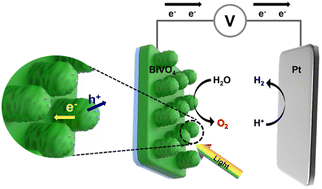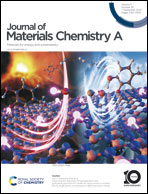Nanostructured BiVO4 obtained by the vanadium calcination of Bi2O3 nanohelixes for enhanced photoelectrochemical water splitting†
Abstract
Although BiVO4 has been investigated as a promising photoanode for solar water splitting, the lack of a nanostructure synthesis method that provides the controllability of the stoichiometric composition prevents the realization of a high-performance BiVO4 photoanode. This paper presents an effective and simple synthetic method for fabricating BiVO4 with a high-quality and unique nanostructure from an array of Bi2O3 nanohelixes using oblique angle deposition via vanadium calcination. The porous open structure of the nanohelical Bi2O3 array facilitates the intrusion of vanadium solution during the solvothermal process, thus allowing for the formation of a BiVO4 nanostructural array with high crystallinity. The combination of significant light-scattering, improved charge separation, and an enlarged active surface area allows for the unique BiVO4 nanostructure to exhibit enhanced optical properties and a photocurrent density of 2.6 mA cm−2 at 1.23 V versus the reversible hydrogen electrode.

- This article is part of the themed collection: #MyFirstJMCA


 Please wait while we load your content...
Please wait while we load your content...